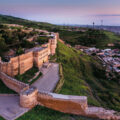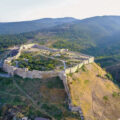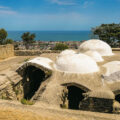In historical literature and various epics of the medieval East, Derbent features as an outstanding fortification erected at the northern limits of the ancient agrarian civilization. Over the centuries, the city was a stronghold of the largest Mediterranean, Near East, and Middle East countries and an important military, political, commercial, economic, and religious center of the region. In 2023, Derbent is celebrating the 20th anniversary of its inscription on the UNESCO World Heritage List.
A city of legends
Ancient Iranian epic literature, vast literary heritage of the Islamic East, and early Christian Syrian lore attribute the foundation of Derbent to epic heroes or prominent tsars, including Alexander the Great. Archeological excavations which Professor Alexander Kudryavtsev undertook in Derbent in 1970 attributed city origins to the transition from the Aeneolithic period to the Bronze Age and established that Derbent is at least 5,000 years old — it is one of the oldest cities in the world and the oldest city in the territory of Russia.
In historical literature and various epics of the medieval East, Derbent features as an outstanding fortification erected at the northern limits of the ancient agrarian civilization. Over the centuries, the city was an important military, political, commercial, economic and religious center of the region. A vantage point crucial for the control of the passage connecting the mountains of the Greater Caucasus and the Caspian Sea, the citadel of Derbent was a target for various invaders throughout ancient history and the Middle Ages: Rome, Parthia, Byzantine and Sasanian Persian Empires sought to dominate the area.
At various points in its history, the city built at the crossroads of world civilizations saw the arrival of four monotheistic religions: Zoroastrianism, Islam, Judaism and Christianity that manifested itself in unique architectural monuments of the fortress of Derbent.
The cradle of Christianity
Medieval Derbent was one of the earliest and most important centers from where Christianity spread. In 313 AD Christianity became a legal religion in the Roman Empire. This facilitated the spread of the new religion throughout Roman dominions and adjacent lands, including Armenia, Georgia and Caucasian Albania of which ancient Derbent was part. According to the writings of distinguished 7th century Albanian author Movses Kaghankatvatsi, tsar Urnair from the Arsacid dynasty of Parthia was baptized by St. Grigoris “turning from many paths of error to true God”. By the time the Caucasus states were attacked by the Sasanian Empire in the 4th century, the population of Derbent was mostly Christian, so the attempts to establish Zoroastrianism failed. Moreover, the commitment to Christianity was one of the crucial factors in the Caucasus-Sasanian confrontation in the region.
Called the Caspian Gates by ancient Greek and Roman sources and the Caspian Wall by later records, Derbent played an important part in the history of military, political and ideological confrontation in the Caucasus.
According to Movses Kaghankatvatsi, the first attempts to spread the Holy Scriptures in Derbent date back to the Apostolic Age, i.e. 1st century. Christian scholars believe that the Church of Albania is one of the oldest Christian churches in the world and has apostolic origin, i.e. it was founded by disciples of Christ, St. Bartholomew and St. Thaddaeus the Apostles, as well as by St. Eliseus, a disciple of Thaddaeus. According to Movses Kaghankatvatsi, after the martyr’s death of his teacher Apostle Thaddaeus, “St. Eliseus returned to Jerusalem and told the other Apostles about Thaddaeus’ coveted martyrdom”. Having shared the news of Thaddaeus’ death and determined to take up his teacher’s cause in Caucasian Albania, Eliseus was “ordained under the inspiration of the Holy Spirit by St. James, the Brother of Our Lord, the first Patriarch of Jerusalem”. Following in Thaddaeus’ steps, Eliseus “took charge of the East and set out for Persia visiting the Maskut (an Iranian speaking group who lived in the south of modern Dagestan) and avoiding Armenia and began preaching in Chol (that’s how Georgian, Armenian and Albanian sources referred to Derbent)”. Bearing in mind the lifetime of St. James, the first Patriarch of Jerusalem, Eliseus must have arrived in Chol not later than the early 60s of the 1st century.
By the late 4th–early 5th century, the new religion established itself in the region, and thanks to King Vache II of Albania who stirred up an anti-Iranian rebellion and moved his capital to Derbent, the city became one of the Christian centers of the Caucasus. According to Movses Kaghankatvatsi, from the 60s of the 5th century Derbent was the seat of the head of the Church of Albania (Catholicos of Caucasian Albania). Not for long, though. In the middle of the 6th century, the principal church was moved from Derbent to Partav as a result of Khazar attacks.
Witnesses of the past
Derbent boasts two examples of monumental church architecture that date back to the period of the widespread expansion of Christianity: a cross-shaped building in the citadel and a three-aisled basilica in the old part of the medieval town. After the arrival of Arabs, the basilica was converted into a mosque which has survived to this day. Today the Juma Mosque of Derbent is the oldest mosque in Russia and the CIS.
The cross-shaped building in the citadel boasts an even more intriguing past. For a long time it was thought to be an underground water tank carved into rock. Yet, excavations that started in the 1970s revealed that it could not have been the case. First of all, during the early Middle Ages the entire building stood on the ground level. Secondly, a network of water passages composed of ceramic pipes and stone groves was only discovered in the 17th-19th century layers. Archeologists assumed that the building did serve as a water tank but at a much later time and after major redesign. But what could be its initial purpose?
To answer this question, a number of scientists were invited to study the historic site. The Elementary Particle Lab of the Pyotr Lebedev Institute of Physics of the Russian Academy of Sciences studied the building in the citadel of Derbent using the unique muon radiography method. Muons are elementary particles produced by cosmic rays which can penetrate through walls which are several meters thick or through the ground. By registering the absorption and diffusion of muon beams, it is possible to discover voids and cavities in old masonry without removing the walls and floor.
Experts from Moscow also used ground penetrating radar scanning, laser scanning and photogrammetry to study the building’s “biography”: they discovered a number of alterations and additions which made it clear that the original building served as an early Christian church and was converted into a water tank at a later stage. Photogrammetry was used to create a 3D model of the underground section. It transpired that the proportions of the crossed-dome building conform to the canons of early Christian churches. The floorplan has the form of a plain cross oriented in the cardinal directions. The ends of the cross are covered by pointed arches, while the central part is crowned with a ribbed vault, which allows for a smooth transition from the round dome to the square base. The floorplan is not typical of local water tanks which were shaped either as a square or rectangle throughout ancient history and the Middle Ages. Instead, it is reminiscent of early Christian architecture of the Caucasus, Asia Minor and Italy.
Researchers believe that the Christian church was built in the citadel of Derbent in the 5th century when King Vache II of Albania turned the city into the main stronghold of Christianity in the Caucasus and the seat of the head of the Church of Albania. This theory is supported by the fact that two upper layers of wall plaster contain waterborne bacteria, while the earliest layer has no sign of them which means that it was not exposed to water. Researches believe that the 5th century church was abandoned after the Arabs established themselves in Derbent (8th-9th century) and restored or redesigned in the 17th-early 18th century to serve as a water tank. If this theory is confirmed, it will be safe to refer to the unique monument in the citadel of Derbent as the oldest Christian church in Russia. Even now it is obvious that Russia’s architectural treasures include one of the oldest buildings of the formative period of Christianity which witnessed the spread of the religion destined to make a lasting impact on the history of humanity.
Alexander Kudriavtsev



